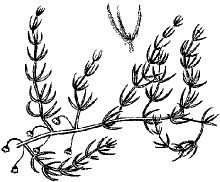 Synonyms: Asparagus
pallasii Miscz., Asparagus ponticus Woronow
Synonyms: Asparagus
pallasii Miscz., Asparagus ponticus WoronowAsparagus brachyphyllus Turczaninov, 1840
 Synonyms: Asparagus
pallasii Miscz., Asparagus ponticus Woronow
Synonyms: Asparagus
pallasii Miscz., Asparagus ponticus Woronow
Common names: Engl: Short-leaved asparagus; Bulg: Asperja; Russ: Sparzha korotkolistnaya, Sparzha Pallasa; Turk: Asparagus; Ukr: Kholodok korotkolysty, Kholodok Pallasa
Order: ASPARAGALES
Family: ASPARAGACEAE
Taxonomic descriptions: It is a perennial prostrate grass with slightly rising wriggled curved thin stems (2-3 mm in diameter) in a top part. Cladodes are 5-10 mm lengthwise fan-like diverging and slightly sickle-like curved, dove-coloured, in bundles of 3-6 ones. The plants are dioecious, flowers are unisexual, they are located at the main lateral branches, one or two at a floriferous stem. The foetus is a berry.
 IUCN Status:
IUCN Status:
World level: NE
Black Sea Regional level: VU
Subregion level: VU in Ukraine
Distribution:
Habitats type, Critical habitats, Limiting factors: Littoral strip, steppe and salinic lands closed to the sea coast or salty lakes. Critical habitats: steppe Crimea near Razdol'noye, sandy coast of Karkinit Bay, northern coast of Kerch peninsula (Bagerovo, Kurortnoye). Limiting factors: phytophagans feeding, elimination during storms and severe weather conditions.
Biology: Reproduction - by seeds and vegetatively. The species has early spring development of overground shoots.
Population trends: The population is not numerous. Its area is decreasing because of habitat destruction.
Threats: Habitats reduction or complete destruction due to cattle grazing; local people pick up this plant for bunches decoration.
Conservation measures taken: The species has been entered in the Red Data Books of Bulgaria and Ukraine. It is conserved in the Belosaray spit reservation (Donetsk region, Ukraine).
Conservation measures proposed: Complete inventory of locations, the monitoring of populations, natural reservations organization.
References:
Compiled by: L. Vakhrusheva